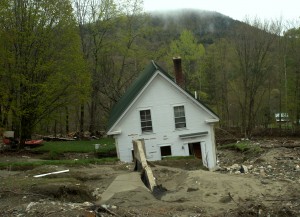
Great documentaries come in as many points of view as there are film makers.
Spike Lee’s ‘When the Levees Broke: A Requiem in Four Acts’ (2006) shows only enough footage of Hurricane Katrina blowing through to set the stage for dozens of human dramas that run through its 255 minutes.
Seven and a half years after Katrina – with the intervening wakes of Irene, Sandy and Nemo – ‘When the Levees Broke’ presents a now familiar story with familiar villains and unfamiliar heros. Dozens of heros.
No matter how well you think you know the story, Lee will move you, shock you, make you think.
Lee shows little of New Orleans before Katrina. He relies on the longing in its victims’ descriptions of what they lost. And, they are eloquent. There is no narrator. Contemporary news footage and interviews over the following eight months carry the story lines.
The villains, headed by President George W. Bush and Louisiana Governor Kathleen Blanco, get less screen time than the invective hurled at them by residents and critics. The Rev. Al Sharpton, a New Yorker, is one of the calmer voices.
The eerie footage – widely shown at the time – of Bush, alone, staring out the window of Air Force One, on his first New Orleans flyover reminded me of photos of a brooding Hitler staring out the window of the Eagles Nest seeing God knows what.
‘When the Levees Broke’ would be worth watching for no other reason than to remind what ‘individual responsibility’ means in the face of a catastrophe. Each survivor’s story should be a permanent antidote for the delusional social policies of the right.
The Federal Emergency Management Agency (FEMA) and the US Army Corps of Engineers take the brunt of survivor anger in Lee’s telling. The state of Louisiana – one of the models of low taxes low services states – gets far less of a hit than it earned.
The barricading of New Orleans’s neighboring parishes against their fellow citizens continues to shock. No matter how bad the storm and its effects were, what people did made Katrina a catastrophe rather than a disaster.
Ray Nagin, then Mayor of New Orleans, seems unflustered, somewhat ambivalent, somewhat sympathetic. His habitual hint of a smile gives him an air of untrustworthiness, regardless of what he is saying. And, Lee gives Nagin his say.
So, too, some of the compelling survivors. Garland Robinette talks emotionally about communicating New Orleans’s desperation over the booming voice of WWL-AM and leaves no doubt of its current needs.
Phyllis Montana LeBlanc has, perhaps the most time on screen. From the flood to taking refuge at the New Orleans airport to months of agony about her family’s fate to the arrival of her FEMA trailer, her story is the documentary’s clearest narrative thread.
It is no coincidence that the compelling first season of ‘Treme’ features Montana LeBlanc and Wendell Pierce whose story is almost as prominently told. Having watched ‘Treme’ before ‘When the Levees Broke’, I had a nagging sense of watching it again with different actors.
The art in making a great documentary is focus. Lee offers little or no background or foregroundfor the people he features. They are in a moment describing a singular event. The colorful history of, for instance, Garland Robinette, Lee alludes to not at all.
Of course, ‘When the Levees Broke’ speaks more of anger and grief than it does of heroism or villainy or indifference. The inexcusable delays – months, not days – in offering basic relief would dictate that. So, too, the agonies of New Orleans families dispersed – without means to communicate – from Utah to Texas to Oklahoma to Georgia….
Still, the omission of relief efforts by individuals and organizations is noticeable, as is the bare nod to the national outrage the state of Katrina’s survivors provoked.
One scene deserved more explanation than it got. In a sequence about the sorry performance of the New Orleans and Louisiana public safety officers and of the US Army, a three-star general comes on a street corner guarded by a tank with a rifleman at the ready in its turret and infantry with weapons poised. He angrily orders the weapons put down. The officer isn’t credited.
The general is black; his soldiers are white. Lee allows the survivors, black and white, to express outrage at what still seems racist indifference to New Orleans’s plight. No fair-minded person can doubt it existed in some measure.
But Spike Lee refuses to let us – his viewers, his society, his government, himself – off with an easy ‘it’s the South’ explanation. He gives fair measure to the political, social and environmental dimensions of Katrina. It is a complex story.
While ‘When the Levees Broke’ is a masterpiece of the documentary form, it is about outrage – that felt by Katrina’s survivors and that inspired in its viewers. For more than anything else it is about people who just want to go home.
When Fats Domino sings ‘I’m Walking to New Orleans’ (1960) over the closing credits, it’s more than one can bear.
Recent Comments